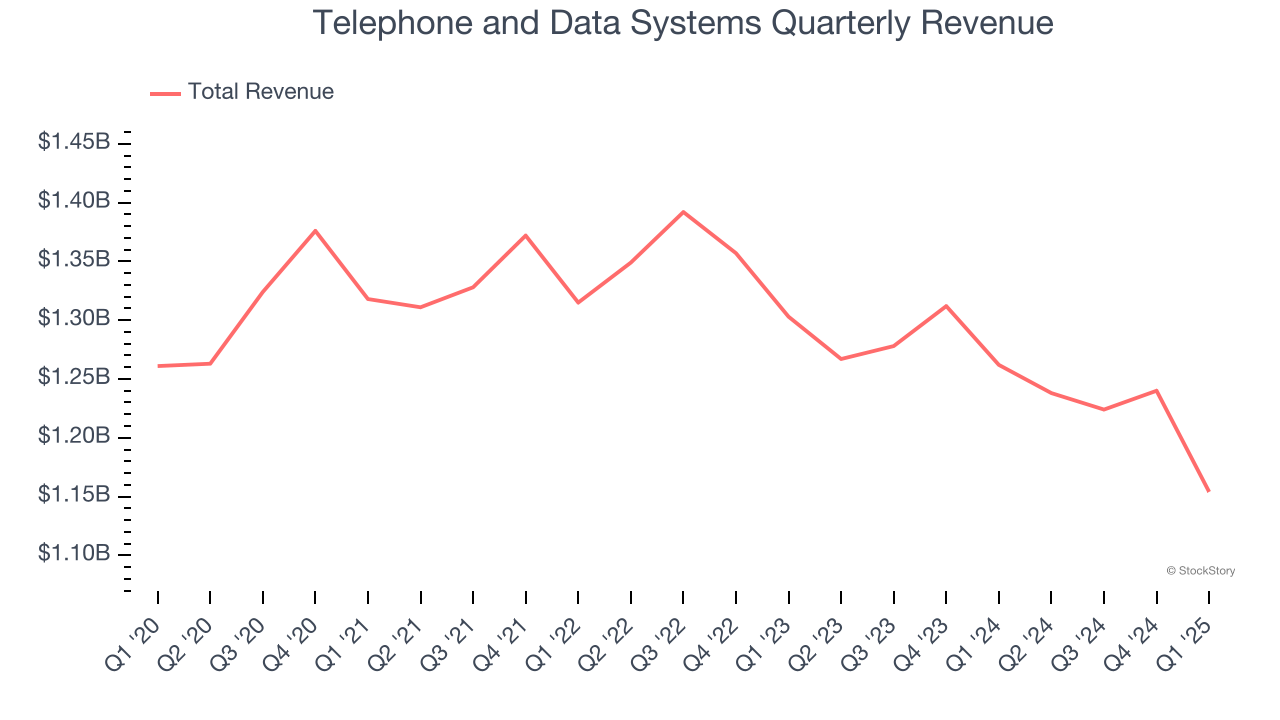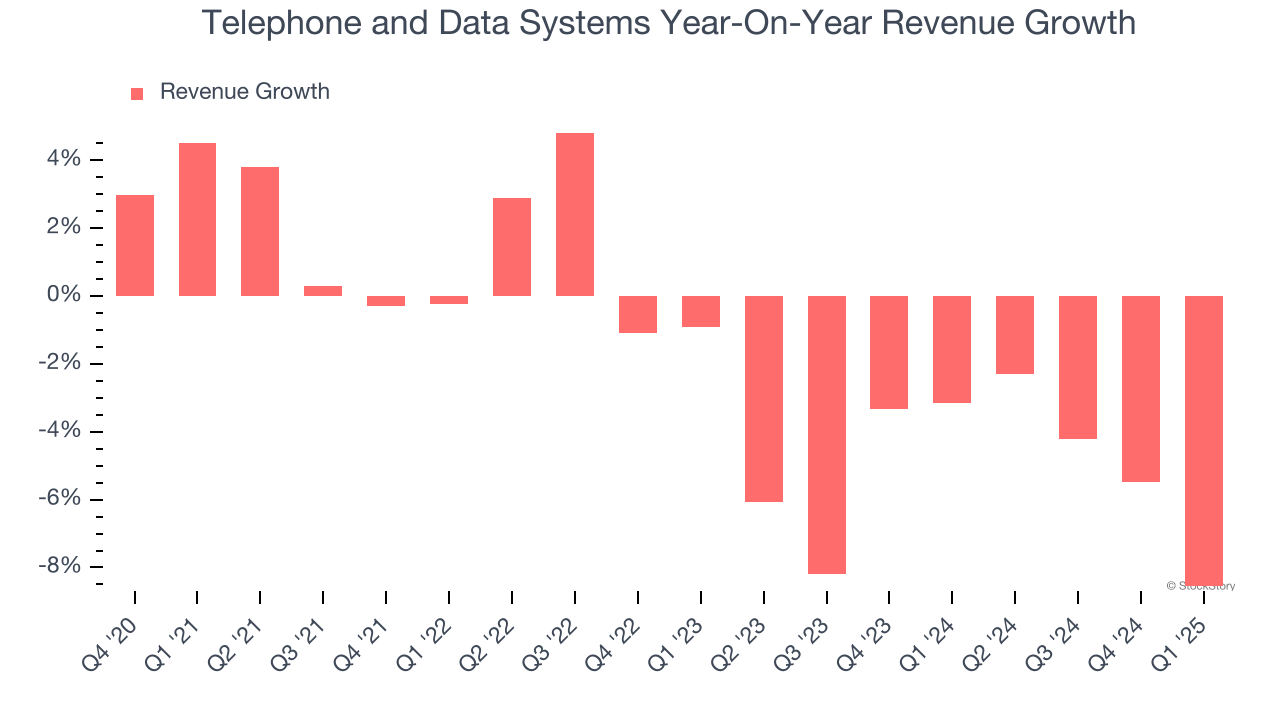
Telecommunications services provider Telephone and Data Systems (NYSE: TDS) fell short of the market’s revenue expectations in Q1 CY2025, with sales falling 8.6% year on year to $1.15 billion. Its GAAP loss of $0.09 per share was significantly below analysts’ consensus estimates.
Is now the time to buy Telephone and Data Systems? Find out by accessing our full research report, it’s free.
Telephone and Data Systems (TDS) Q1 CY2025 Highlights:
- Revenue: $1.15 billion vs analyst estimates of $1.18 billion (8.6% year-on-year decline, 2.1% miss)
- EPS (GAAP): -$0.09 vs analyst estimates of -$0.01 (significant miss)
- Adjusted EBITDA: $297 million vs analyst estimates of $347.5 million (25.7% margin, 14.5% miss)
- Operating Margin: 3%, down from 5.8% in the same quarter last year
- Free Cash Flow was $57 million, up from -$11 million in the same quarter last year
- Market Capitalization: $4.32 billion
"As we work towards the expected mid-2025 closing of the sale of the wireless operations, the remaining businesses – fiber and towers – are making foundational changes that will support TDS' transformation," said Walter Carlson, TDS President and CEO.
Company Overview
Operating primarily through its majority-owned subsidiary UScellular and wholly-owned TDS Telecom, Telephone and Data Systems (NYSE: TDS) provides wireless, broadband, video, and voice communications services to 4.6 million wireless and 1.2 million broadband customers across the United States.
Sales Growth
Examining a company’s long-term performance can provide clues about its quality. Any business can put up a good quarter or two, but the best consistently grow over the long haul.
With $4.86 billion in revenue over the past 12 months, Telephone and Data Systems is one of the larger companies in the business services industry and benefits from a well-known brand that influences purchasing decisions. However, its scale is a double-edged sword because it’s harder to find incremental growth when you’ve penetrated most of the market. To accelerate sales, Telephone and Data Systems likely needs to optimize its pricing or lean into new offerings and international expansion.
As you can see below, Telephone and Data Systems struggled to generate demand over the last five years. Its sales dropped by 1.6% annually, a poor baseline for our analysis.

Long-term growth is the most important, but within business services, a half-decade historical view may miss new innovations or demand cycles. Telephone and Data Systems’s recent performance shows its demand remained suppressed as its revenue has declined by 5.2% annually over the last two years. 
This quarter, Telephone and Data Systems missed Wall Street’s estimates and reported a rather uninspiring 8.6% year-on-year revenue decline, generating $1.15 billion of revenue.
Looking ahead, sell-side analysts expect revenue to decline by 2.3% over the next 12 months. Although this projection is better than its two-year trend, it's hard to get excited about a company that is struggling with demand.
Software is eating the world and there is virtually no industry left that has been untouched by it. That drives increasing demand for tools helping software developers do their jobs, whether it be monitoring critical cloud infrastructure, integrating audio and video functionality, or ensuring smooth content streaming. Click here to access a free report on our 3 favorite stocks to play this generational megatrend.
Operating Margin
Operating margin is one of the best measures of profitability because it tells us how much money a company takes home after subtracting all core expenses, like marketing and R&D.
Telephone and Data Systems was profitable over the last five years but held back by its large cost base. Its average operating margin of 3.8% was weak for a business services business.
Analyzing the trend in its profitability, Telephone and Data Systems’s operating margin decreased by 3.4 percentage points over the last five years. Telephone and Data Systems’s performance was poor no matter how you look at it - it shows that costs were rising and it couldn’t pass them onto its customers.

In Q1, Telephone and Data Systems generated an operating profit margin of 3%, down 2.8 percentage points year on year. This contraction shows it was less efficient because its expenses increased relative to its revenue.
Earnings Per Share
Revenue trends explain a company’s historical growth, but the long-term change in earnings per share (EPS) points to the profitability of that growth – for example, a company could inflate its sales through excessive spending on advertising and promotions.
Sadly for Telephone and Data Systems, its EPS declined by 24% annually over the last five years, more than its revenue. This tells us the company struggled because its fixed cost base made it difficult to adjust to shrinking demand.

We can take a deeper look into Telephone and Data Systems’s earnings to better understand the drivers of its performance. As we mentioned earlier, Telephone and Data Systems’s operating margin declined by 3.4 percentage points over the last five years. This was the most relevant factor (aside from the revenue impact) behind its lower earnings; taxes and interest expenses can also affect EPS but don’t tell us as much about a company’s fundamentals.
In Q1, Telephone and Data Systems reported EPS at negative $0.09, down from $0.10 in the same quarter last year. This print missed analysts’ estimates. Over the next 12 months, Wall Street is optimistic. Analysts forecast Telephone and Data Systems’s full-year EPS of negative $1.05 will reach break even.
Key Takeaways from Telephone and Data Systems’s Q1 Results
We struggled to find many positives in these results. Its revenue missed significantly and its EPS fell short of Wall Street’s estimates. Overall, this quarter could have been better. The stock traded down 3.3% to $36.37 immediately following the results.
The latest quarter from Telephone and Data Systems’s wasn’t that good. One earnings report doesn’t define a company’s quality, though, so let’s explore whether the stock is a buy at the current price. We think that the latest quarter is only one piece of the longer-term business quality puzzle. Quality, when combined with valuation, can help determine if the stock is a buy. We cover that in our actionable full research report which you can read here, it’s free.


